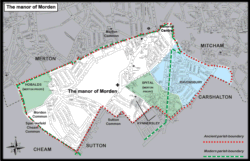The manor of Morden

Map of Morden Manor
Download a reconstruction map of Morden Manor in medieval times
Westminster Abbey had owned an estate in Morden (usually spelt Mordon) from before the Norman Conquest. Domesday Book, a survey commissioned by William the Conqueror in 1086, states: ‘The Abbey of Westminster itself holds Morden. TRE [In the time of King Edward] it was assessed at 12 hides; now at 3 hides. There is land [blank]. In demesne are 3 ploughs; and 8 villans and 5 cottars with 4 ploughs. There is 1 slave, and a mill rendering 40s. TRE it was worth £6; now £10, and yet it renders £15.’1
A hide was primarily a unit of assessment for tax purposes, but was considered to be the amount of land sufficient to support a free family. A quarter of a hide was called a virgate, also essentially an assessment for tax and services, but with a land equivalent. The customary virgate in Morden was 20 acres,2 but freehold virgates could vary from this.
The original charters granting Morden to Westminster Abbey do not survive, and the documents that purport to be copies of early royal confirmations of the grant are considered to be 12th-century forgeries. The 11th and 12th centuries saw the forging of many charters at Westminster and elsewhere. Although some were deliberate fabrications intended to secure rights and privileges that were not included in the originals, others were merely attempts to recreate originals damaged by fire, water or rodents.3
One of these forged documents claimed that in AD969 king Edgar confirmed an earlier grant to the Abbey of ‘liberties and land’ including 10 hides at Morden.4 Edgar had apparently ‘given’ the church at Westminster to Dunstan bishop of London in 959, with permission to establish a Benedictine monastery there,5 and another forged charter records Dunstan’s endowment of the Abbey that year with various estates. These included 2 hides in Ewell 6 which came to be administered from Morden and which, known as ‘Morden Fee’, brought the Morden estate up to the 12 hides recorded in Domesday.
It has sometimes been stated that the Abbey obtained its Morden estate under the will of prince Athelstan, eldest son of king Ethelred, who predeceased his father in 1015.7 In his will he granted ‘to Christ and St Peter, at the place where I shall be buried’ three estates, one of which was ‘the estate at Morden which my father let to me’.8 However, the estate in question was Steeple Morden in Cambridgeshire, and the church of St Peter was not that at Westminster, but the Old Minster at Winchester. Steeple Morden was presumably the estate exchanged by bishop Henry de Blois for Bishops Sutton, in Hampshire, belonging to his brother, king Stephen, which is also sometimes confused with our Morden.9
According to the Tithe Apportionment schedule of 1838 the ancient parish of Morden contained 1433 acres, of which 1343½ acres were subject to tithe, the 83¾-acre Common, the churchyard and part of the glebe being tithe-free.10
Not all of the parish of Morden was in the manor of Morden. A compact block of land comprising 215½ acres in Morden parish belonged to the manor of Ravensbury, which had further lands in the adjoining parish of Mitcham. Another plot, a 4-acre meadow, (plot 353) had been part of Ravensbury manor until the 16th century, and a further 28 acres to the east of Ravensbury may have belonged to the precursor of Ravensbury manor until the 14th century. It is not known when the Ravensbury lands became separated from the manor of Morden – the first specific statement that the estate that became Ravensbury manor had lands ‘in Mitcham and Morden’ was in 1321.11
A virgate-holding in Morden had come into the hands of the lords of the neighbouring manor of Kynnersley in Carshalton, and was leased back to Westminster Abbey at 4 shillings a year between 1283 and 1450.12 The lease probably originated in grants of c.1195×1215 and c.1217×21, but it is not known when the land had been alienated from the Abbey’s manor.13
Two other estates in Morden came into the possession of neighbouring Merton Priory. The 150-acre Spital estate lay to the south-west of Ravensbury, and to the east of Green Lane. There is a reference to ‘Le Spitellondegrove’ in the Morden manorial account roll for 1302/03,14 but other documents give the impression that Merton Priory had an interest in land in this area around the end of the 12th century.15 Part of the Hobalds estate, on the site of the present North-East Surrey Crematorium, was given to Merton Priory between 1225 and 1246, on the understanding that the priory would pay rent to Westminster Abbey, but no such payments are recorded in the manorial account rolls, which survive from 1280.16
Westminster Abbey’s lands were divided between the demesne land, worked on behalf of the Abbey, and tenant land, held by tenants in return for rents and services. Barbara Harvey remarks of the Morden estate, ‘In 1086, Morden, in Surrey, and Kelvedon, in Essex, were certainly at farm, for each rendered to the monks a sum (or perhaps the equivalent in kind) in excess of its Domesday value’.17 However, by the time of the first extant account roll in 1280 the demesne land was worked by staff appointed by and responsible to the Abbey for the proceeds of the estate. This situation continued until 1359, when the demesne was again leased ‘at farm’ to tenants, for a fixed period of years at a fixed rent, the final lease being surrendered to the Abbey’s successors in 1568.18
 MERTON HISTORICAL SOCIETY
MERTON HISTORICAL SOCIETY